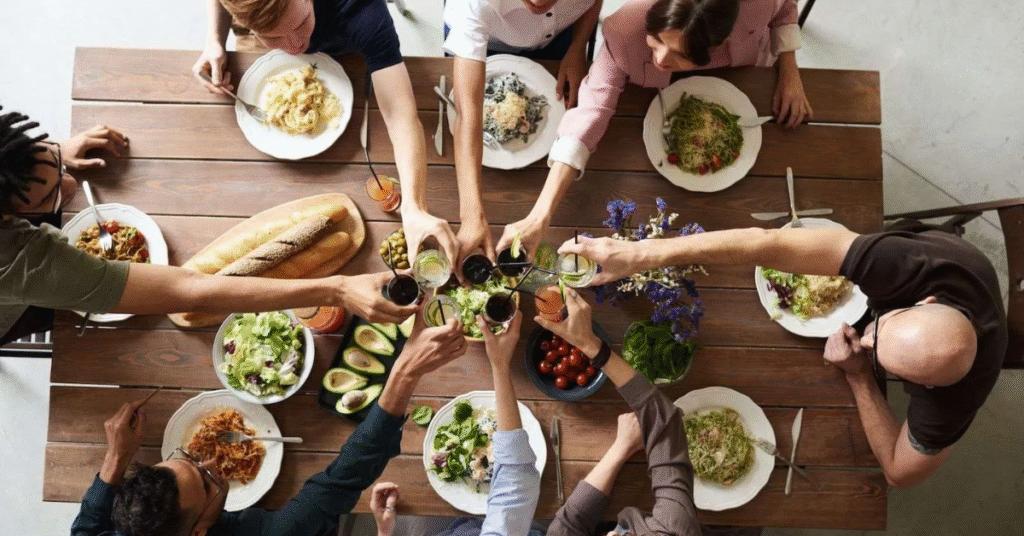In today’s fast paced world, eating has become more of a mechanical habit than a conscious activity. Many of us eat on the go, in front of a screen, or while multitasking, often without realizing how much we’re consuming or how we’re feeling. This disconnection from the eating process can lead to overeating, poor digestion, and a lack of satisfaction. Mindful eating offers a refreshing alternative one that reconnects us to the here and now and fosters a healthier relationship with food.
What is mindful eating
Mindful eating means paying full attention to the experience of eating and drinking, both internally and externally. This involves noticing colors, smells, textures, flavors, temperatures, and even the sounds of the food. Mindfulness also means being aware of the body’s hunger and satiety signals, emotional triggers, and the thoughts that arise during eating.
Unlike dieting, mindful eating isn’t about restricting food or counting calories. It’s about raising awareness and developing a more conscious, intuitive approach to food.
Eat Slower
One of the simplest yet most effective ways to eat mindfully is to eat more slowly. If you eat too quickly, your brain doesn’t have enough time to register that you’re full, which can lead to overeating.
Tips for slowing down:
Put your utensils down between bites.
Chew each bite thoroughly 20-30 times.
Breathe deeply between bites.
Set a timer and try to stretch your meal to 20 minutes or more.
Eating without distractions
Mindful eating requires your full attention. Eating while watching TV, browsing your phone, or working can distract you from the actual meal and lead to unconscious overconsumption.
Try the following:
- Set fixed times for screen-free meals.
- Create a quiet, distraction-free dining area.
- When eating with others, focus on the conversation and the food, not on technology.
Pay attention to hunger and satiety cues
Many people eat for reasons other than hunger stress, boredom, sadness, or out of habit. Mindful eating helps you differentiate between physical hunger and emotional cravings.
Hunger Check:
Ask yourself before eating:
- Am I really hungry, or am I just bored or stressed?
- Where do I feel hunger—in my stomach or in my head?
- How hungry am I on a scale of 1 (not at all) to 10 (starving)?
After eating, ask yourself:
- Am I comfortably full or overstuffed?
- Did I enjoy my meal?
- Would I choose differently next time?
Appreciate Your Food
Gratitude is an important component of mindfulness. Taking a moment to appreciate your food can shift your mindset and make mealtimes more fulfilling.
Ways to develop gratitude:
- Think about where your food comes from farmers, shippers, cooks, etc.
- Take a moment to silently thank others for the food before eating.
- Before taking the first bite, focus on the beauty and aroma of your food.
Focus on the Sensory Experience
Mindful eating is a multisensory experience. By engaging all of your senses, you’ll strengthen your connection with food and notice when you’re full.
Sensory stimuli to explore:
- Sight: Observe the colors and presentation.
- Smell: Breathe in the aromas before taking a bite.
- Taste: Notice how the flavor changes as you chew.
- Touch: Feel the texture with your fingers or tongue.
- Hearing: Listen for the crunch, sizzle, or bubbling of your food.
Start with small portions
By choosing smaller portions, you can better assess your hunger and avoid overeating. This also gives you the opportunity to consciously eat more if you’re still hungry.
Portion tips:
- Use smaller plates and bowls.
- Wait 10 minutes after your first serving before deciding on a second helping.
- Focus on quality over quantity.
Keep a food journal
Even though mindful eating isn’t associated with counting calories, a food and mood journal can help you become aware of your eating habits, triggers, and emotional patterns.
Journal suggestions:
- What did I eat and when?
- How did I feel before and after eating?
- Was I really hungry, or was something else influencing my eating behavior?
- Did I enjoy the food?
Practice mindfulness outside of mealtimes
Mindful eating is easier when it’s part of a broader mindful lifestyle. The more mindfulness you practice in other areas, the more naturally it will affect your eating habits.
Mindfulness exercises:
- Meditation or deep breathing.
- Yoga or gentle exercise.
- Spending time in nature.
- Pursuing hobbies that require focus and presence.
Approach emotional eating with compassion
Emotional eating is common and often has its roots in deeper needs. Instead of judging yourself, use mindfulness to approach emotional eating with curiosity and kindness.
Steps to combat emotional eating:
- Pause and notice what you’re feeling.
- Ask yourself, “What do I really need right now?”
- Try alternative coping strategies: taking a walk, calling a friend, journaling.
- If you still want to eat, do so mindfully and without guilt.
Cook and prepare meals mindfully

Mindfulness can begin long before the first bite. Mindful shopping, preparing, and cooking can deepen your relationship with food.
Mindful cooking practices:
- Choose fresh, colorful ingredients.
- Cook without multitasking focus on each step.
- Involve all of your senses when cooking smell, appearance, texture.
- End the day with gratitude for the food you prepared.
Foster Intuitive Eating
Mindful eating aligns well with intuitive eating. It encourages you to listen to your body’s internal cues rather than external dietary guidelines.
Principles of Intuitive Eating:
- Discard the diet mentality.
- Respect your hunger and satiety.
- Make peace with food no food is “good” or “bad.”
- Honor your health through mindful eating, not restriction.
Be patient and forgiving with yourself
Mindful eating is a process, not a goal of perfection. There will be times when you eat mindlessly or emotionally. The key is to notice this, reflect, and return to mindfulness without judgment.
Kindness Practices:
- Talk to yourself as you would to a friend.
- Reflect without blame what happened and what can you learn from it?
- Celebrate small successes, like taking a break before eating or a bite you enjoy.
Engage your community
Mindful eating can be more enjoyable and sustainable together. Mindful eating with family or friends promotes connection and accountability.
Group ideas:
- Plan mindful meals together.
- Share your food journaling experiences (if you feel comfortable).
- Host mindful eating challenges or potlucks.
Understand the benefits of mindful eating
Mindful eating not only improves your relationship with food it also has real, measurable health benefits.
Evidence-based benefits:
- Reduces overeating and binge eating.
- Improves digestion and gut health.
- Increases satisfaction and enjoyment of meals.
- Promotes weight stability or gentle weight loss.
- Reduces stress and improves overall mental health.
Conclusion:
Rediscover your food, rediscover yourself.
Mindful eating invites you to eat more slowly, savor it, and truly connect with your food and your body. This transforms eating from a mindless routine into a nourishing ritual. By incorporating even a few of these tips into your daily routine, you can develop a more peaceful, joyful, and healthier relationship with food, bite by bite.more info.
